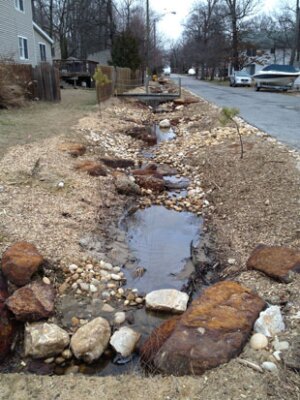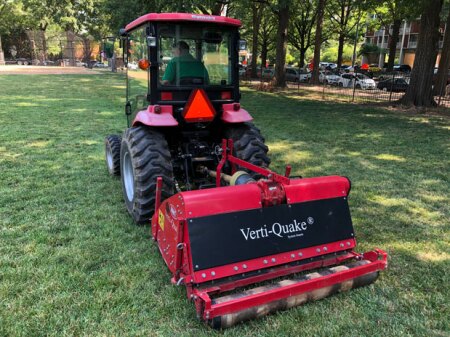Partially adapted from the Cloudburst Infrastructure Workshop for New York City Housing Authority report, authored by Janice Barnes and Leo Temko of Climate Adaptation Partners.
In September 2021, Hurricane Ida barreled across the Caribbean and the United States, causing $75 billion in damage. The northeast U.S. was taken by surprise by the storm’s severity as 3 inches of rain fell in an hour. New York City was left reeling as basements, subways, and lower-lying streets and roadways flooded suddenly under the heavy rainfall, and 17 people lost their lives, many trapped in basement apartments.
Extreme rain events, whether from hurricanes like Ida or Harvey or cloudbursts like the one that hit Copenhagen in 2011, dumping six inches of rain on the city in under 3 hours and causing $1 billion in damage, are increasing in frequency due to climate change, and many cities’ infrastructure and landscapes are not equipped to manage the intense volumes of water.
Further, storm and sewer drains are slow, expensive, and disruptive to update for higher volumes, and channeling water directly out of the landscape creates missed opportunities to enhance landscapes with green infrastructure, biodiversity, and restorative recreational space for urban residents.
The New York City Housing Authority (NYCHA) recognized this challenge and recently sought innovative strategies through a one-day workshop with ULI New York and ULI’s Urban Resilience Program to address cloudburst events for its portfolio, consisting of over 300 developments serving 400,000 low- and moderate-income residents.
Below are five of the innovative strategies presented to NYCHA that developers, owners, and cities can use to boost a landscape’s ability to handle extreme rain and cloudbursts, by slowing down the flow of water, storing water in floodable areas, or restoring natural ecosystems. Read about the rest of the solutions and the workshop here.
Smart Roofs
Roof space is a valuable resource that often goes underutilized. At time of replacement, roofs can be developed into multifunctional green-blue-solar spaces to increase biodiversity, cool buildings, store water, and host renewable energy simultaneously. The ‘green’ component grows plants in a lightweight medium above a ‘blue’ water storage system, which captures water during rain events and then evaporates it slowly afterwards. The vegetation cools the microclimate around the solar panels improving their efficiency, while the panels themselves provide additional shading and cooling of the roof and building, reducing energy use. What makes these systems ‘smart’ is technology that regulates how much stormwater is stored based on weather forecasts and local conditions, reducing roof-load issues and preventing stormwater damage to the roof.
Self-Draining Sidewalks
Pathways and sidewalks are also an immense resource that can be retrofitted into water management systems, especially when combined with water storage and conveyance systems located underneath. The Climate Tile, developed by Tredje Natur and piloted in Copenhagen’s Nørrebro district, allows water to pass through concrete tiles into a pipe system that either temporarily stores or directs flow into vegetated landscaped areas shaped to hold water, where it can be taken up by plants and absorbed into the soil, reducing loads on the sewer system. Smart technology can even be integrated to provide data on water levels, and roof drains can be connected to the system to reduce additional runoff.
Infiltration Boxes
Infiltration boxes can greatly expand underground water storage capacity and require no space above ground, making them ideal for parking lots, sports fields, or other multipurpose areas. Made of concrete or plastic tubes wrapped in filter cloth and connected to storm drains, these boxes store high volumes of water during rainfall and then slowly release it into the soil, helping restore groundwater while reducing flooding. Their modular nature and variety in available sizes mean they can be scaled up or down easily, remaining customizable to a single driveway or neighborhood-level installation.
Step Pools
Drawing on the inspiration of the headwaters (or source) of rivers and streams, step pools are repetitive sequences of shallower, calmer areas that can be formed between steeper-sloped areas of water channels in a staircase-like formation, transporting water safely during storms. These can be introduced in gutters next to roads and paths, using rocks and stones to slow down the velocity of water while providing an attractive water feature. Step pool channels require no vegetation and are effective in filtering stormwater sediments and pollutants as the water is conveyed, and some stormwater flow is absorbed into groundwater during its passage through the pools.
Subsoiling
Subsoiling is the process of loosening and aerating the soil in lawns or other open spaces that have become compacted over time by foot traffic or other uses, using a tractor and an attachment that runs up to 22 inches deep. Subsoiling increases hard, compressed soil’s ability to absorb stormwater and slow runoff, restoring the natural hydrology of the site and cleans and cools water before it enters waterways. Adding compost and seeding deep-rooted groundcover plants will help replenish soil and maintain its structure over time. With relatively low costs, straightforward implementation, and manageable operations and maintenance, this tactic should be one of the first considered for landscape restoration plans to manage heavy rain.
Urban landscapes are critical tools for reducing risk from cloudburst and heavy rain events, and restoring their ability to slow, store, and absorb water is essential to reconnecting cities with their natural hydrology. All buildings, neighborhoods, and cities have untapped roofs, sidewalks, parking lots, roadways, and open spaces that can do more for managing water – thinking creatively about expanding the functionality of these underutilized areas can help create an interconnected network of blue spaces.
These techniques are a sample of the many strategies available for making cities “spongier” – see the full report for more inspiration.











